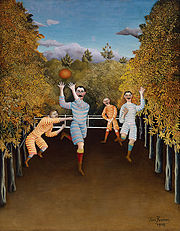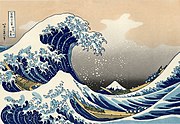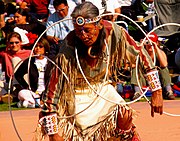The themes of reflection on art
Art and Nature
.jpg/180px-Paul_Cézanne%2C_Les_joueurs_de_carte_(1892-95).jpg)
Paul Cézanne
The Card Players 1892-95
Art does not merely copy nature. However, it did not deter her, but goes back to the source. In Cézanne's painting recalls Merleau-Ponty, it is never color as a simulacrum of the colors of nature, but the dimension of color, where our brain and the universe meet. The artist is sensual, likes to take the personality, the face of things and materials, as the piece of yellow wall which Proust speaks about Vermeer.
Precisely because the still life is not the apple, but the representation of the apple for the first time I can see it instead of thinking or crunching, consider his appearance, not its essence or its usefulness. It is in this sense that art derealizes its purpose, as outlined Sartre43, following Kant. The sea is an impressionist painter colored surface appearance, not the living environment of marine organisms. In What Is Literature? The same Sartre, without contradiction, showing that it is poetry which for the first time the word object, thing, when he was previously a member exploration of the world, like the antennae of insects.
Because "the art of seeing (as defined in drawing and painting) is opposed to see who recognizes objects" (Paul Valéry). The visible is sensual, too: light and distance, yet it shines the light of our own desires.
Being attentive to the sensitive, yet, as we are invited Henri Focillon in his life forms (1934), studying the possibilities of a specific material such as wood, stone, wire ink calligrapher. Consider, however, here the word "material" in a broader sense: the Gothic architecture is as much made of light, or vertical, that stone. On the aesthetic point of view, time and space themselves are the stuff of experience, as the language of thought. These are not just abstract shapes. And, of course, art does not merely explore the foundations of sensory experience, it takes intimate knowledge of this logic, or the geometry, structure and unsuspected effects first.
Arts and representations

Henri Rousseau
Football players
The concept of "representation" depends on the question that arises at the beginning of the problem and the beginning of art itself before prehistory during the Cretaceous is of particular significance if we are to grasp the meaning a work of art and its relationship to beauty. The work of art is a form of "re-presentation", that is to say that this other reality of the universe. The artwork does not see his report more or less adequate to reality, but it affects product, for example, Munch's paintings do not represent a form of sadness, but produce a feeling, an emotion, which called for some sadness, for other abomination. Perhaps because it is producing affects, and is itself a "world" that the artwork is beautiful (contemporary art is beautiful when it was attached to initiation as the artist trying to get us). Or, as Danto does, he must discard the beauty that was old for a test of conformity of the work for aesthetic judgments. This he explains, through the analysis of certain works contemporaines.
This is the great difficulty of contemporary art: they are often associated with intellectual directions and experiments that can not be read directly and without knowledge of their origins: they are wastelands of discoveries that may become real works in the eyes of humanized machines (post-futurism).
Never has a young work is included without parlaying his genealogy. However we note that the term "art" is too commonly applied to any media spectacular, and that to his detriment.
Mediations artistic exceed and transcend all the problems of world knowledge. The study of physical phenomena and technological developments play an important role, since they often influence the creation tools. An artistic experiment, parallel to scientific experimentation, and just base the development of a new aesthetic, underpinned by the growing role of technology in everyday life.
The art could therefore be used to reproduce eternal concepts designed or invented by the mere contemplation. The origin of art comes from the knowledge of good ideas and things, but beyond that knowledge to present otherwise, thus becoming representation. To the extent that art sets goals (which is of course against his nature), one of the goals of art would be to communicate the profound knowledge gained not only through the senses, but also by the spirit . The art of pure imitation is still far from the truth, the work can be as beautiful as the real thing and is of another order, and never did seize a small part. The imitation of nature never translates the level of beauty, however, that the artistic representation reveals an absolute fit for the artist, a truth of our countryside as personal and inimitable.
Imitation and representation

The Great Wave of Kanagawa
But this production is not necessarily voluntary. Unlike other human productions, the creative act is often outside the field of consciousness. It allows us access to a communication from the spiritual, the timeless, the universal. Nietzsche also believed that art should serve to hide or embellish anything ugly in nature humaine45. Yet today, some art born of modernity, such as cinema, as many seek to embellish human nature to highlight any darkness in the hope may be to extract the seeds of misunderstanding and intolerance.
The film, limits of art, gives credibility to see daily, that update, like the novel, but smaller, a human experience that we can not discover otherwise.
This logic brings art into a necessity, lived from the inside by the artist. The music more than "the art of organizing sounds" reflects the expression of a sound body "other", a form rather unreal conceptualization of communication, it is a total fantasy, which combines the both new performances and design of new construction. Like other arts, it expresses the rational and the irrational, but diverge from myth or magic.
All creative processes operate by the same spirit that guides them, a catharsis which guarantees exceeding the limits to knowledge of the world. Symbiosis sensory nourishes the creative action is the basic form of representation which infers the imagination.

Indian dance
As we approach different, more focused mind to that thought, art must inevitably lead to the continuation of the work of an overbearing nature and confined to evolutionary changes. Trying to overcome these limitations of human thought, art reflected the spiritual substance, almost mystical, almost magical creation. This desire to satisfy our thirst for knowledge is not necessarily unhealthy. Myth and magic are not fundamentally loopholes for lack of rationality of the events that surround us, even if, for some, a confession of weakness, limitations transfigured.
They can sometimes also mark the search for a spirituality lacking. The art however it is still a need to express the world that way. It does not seek to replace reality by another entity better consistency, it seeks not to transgress the limitations inherent to our nature, but seeks to transcend them. Art seeks to use the world of sense to enter a world of mind, or perhaps even that of the soul. In doing so, the art seeks the immanent Standing behind. He tries to prove that human potential is not limited to transformation, but he has conquered the dimension of creation.
Art and Nature
.jpg/180px-Paul_Cézanne%2C_Les_joueurs_de_carte_(1892-95).jpg)
Paul Cézanne
The Card Players 1892-95
Art does not merely copy nature. However, it did not deter her, but goes back to the source. In Cézanne's painting recalls Merleau-Ponty, it is never color as a simulacrum of the colors of nature, but the dimension of color, where our brain and the universe meet. The artist is sensual, likes to take the personality, the face of things and materials, as the piece of yellow wall which Proust speaks about Vermeer.
Precisely because the still life is not the apple, but the representation of the apple for the first time I can see it instead of thinking or crunching, consider his appearance, not its essence or its usefulness. It is in this sense that art derealizes its purpose, as outlined Sartre43, following Kant. The sea is an impressionist painter colored surface appearance, not the living environment of marine organisms. In What Is Literature? The same Sartre, without contradiction, showing that it is poetry which for the first time the word object, thing, when he was previously a member exploration of the world, like the antennae of insects.
Because "the art of seeing (as defined in drawing and painting) is opposed to see who recognizes objects" (Paul Valéry). The visible is sensual, too: light and distance, yet it shines the light of our own desires.
Being attentive to the sensitive, yet, as we are invited Henri Focillon in his life forms (1934), studying the possibilities of a specific material such as wood, stone, wire ink calligrapher. Consider, however, here the word "material" in a broader sense: the Gothic architecture is as much made of light, or vertical, that stone. On the aesthetic point of view, time and space themselves are the stuff of experience, as the language of thought. These are not just abstract shapes. And, of course, art does not merely explore the foundations of sensory experience, it takes intimate knowledge of this logic, or the geometry, structure and unsuspected effects first.
Arts and representations

Henri Rousseau
Football players
The concept of "representation" depends on the question that arises at the beginning of the problem and the beginning of art itself before prehistory during the Cretaceous is of particular significance if we are to grasp the meaning a work of art and its relationship to beauty. The work of art is a form of "re-presentation", that is to say that this other reality of the universe. The artwork does not see his report more or less adequate to reality, but it affects product, for example, Munch's paintings do not represent a form of sadness, but produce a feeling, an emotion, which called for some sadness, for other abomination. Perhaps because it is producing affects, and is itself a "world" that the artwork is beautiful (contemporary art is beautiful when it was attached to initiation as the artist trying to get us). Or, as Danto does, he must discard the beauty that was old for a test of conformity of the work for aesthetic judgments. This he explains, through the analysis of certain works contemporaines.
This is the great difficulty of contemporary art: they are often associated with intellectual directions and experiments that can not be read directly and without knowledge of their origins: they are wastelands of discoveries that may become real works in the eyes of humanized machines (post-futurism).
Never has a young work is included without parlaying his genealogy. However we note that the term "art" is too commonly applied to any media spectacular, and that to his detriment.
Mediations artistic exceed and transcend all the problems of world knowledge. The study of physical phenomena and technological developments play an important role, since they often influence the creation tools. An artistic experiment, parallel to scientific experimentation, and just base the development of a new aesthetic, underpinned by the growing role of technology in everyday life.
The art could therefore be used to reproduce eternal concepts designed or invented by the mere contemplation. The origin of art comes from the knowledge of good ideas and things, but beyond that knowledge to present otherwise, thus becoming representation. To the extent that art sets goals (which is of course against his nature), one of the goals of art would be to communicate the profound knowledge gained not only through the senses, but also by the spirit . The art of pure imitation is still far from the truth, the work can be as beautiful as the real thing and is of another order, and never did seize a small part. The imitation of nature never translates the level of beauty, however, that the artistic representation reveals an absolute fit for the artist, a truth of our countryside as personal and inimitable.
Imitation and representation

The Great Wave of Kanagawa
But this production is not necessarily voluntary. Unlike other human productions, the creative act is often outside the field of consciousness. It allows us access to a communication from the spiritual, the timeless, the universal. Nietzsche also believed that art should serve to hide or embellish anything ugly in nature humaine45. Yet today, some art born of modernity, such as cinema, as many seek to embellish human nature to highlight any darkness in the hope may be to extract the seeds of misunderstanding and intolerance.
The film, limits of art, gives credibility to see daily, that update, like the novel, but smaller, a human experience that we can not discover otherwise.
This logic brings art into a necessity, lived from the inside by the artist. The music more than "the art of organizing sounds" reflects the expression of a sound body "other", a form rather unreal conceptualization of communication, it is a total fantasy, which combines the both new performances and design of new construction. Like other arts, it expresses the rational and the irrational, but diverge from myth or magic.
All creative processes operate by the same spirit that guides them, a catharsis which guarantees exceeding the limits to knowledge of the world. Symbiosis sensory nourishes the creative action is the basic form of representation which infers the imagination.

Indian dance
As we approach different, more focused mind to that thought, art must inevitably lead to the continuation of the work of an overbearing nature and confined to evolutionary changes. Trying to overcome these limitations of human thought, art reflected the spiritual substance, almost mystical, almost magical creation. This desire to satisfy our thirst for knowledge is not necessarily unhealthy. Myth and magic are not fundamentally loopholes for lack of rationality of the events that surround us, even if, for some, a confession of weakness, limitations transfigured.
They can sometimes also mark the search for a spirituality lacking. The art however it is still a need to express the world that way. It does not seek to replace reality by another entity better consistency, it seeks not to transgress the limitations inherent to our nature, but seeks to transcend them. Art seeks to use the world of sense to enter a world of mind, or perhaps even that of the soul. In doing so, the art seeks the immanent Standing behind. He tries to prove that human potential is not limited to transformation, but he has conquered the dimension of creation.